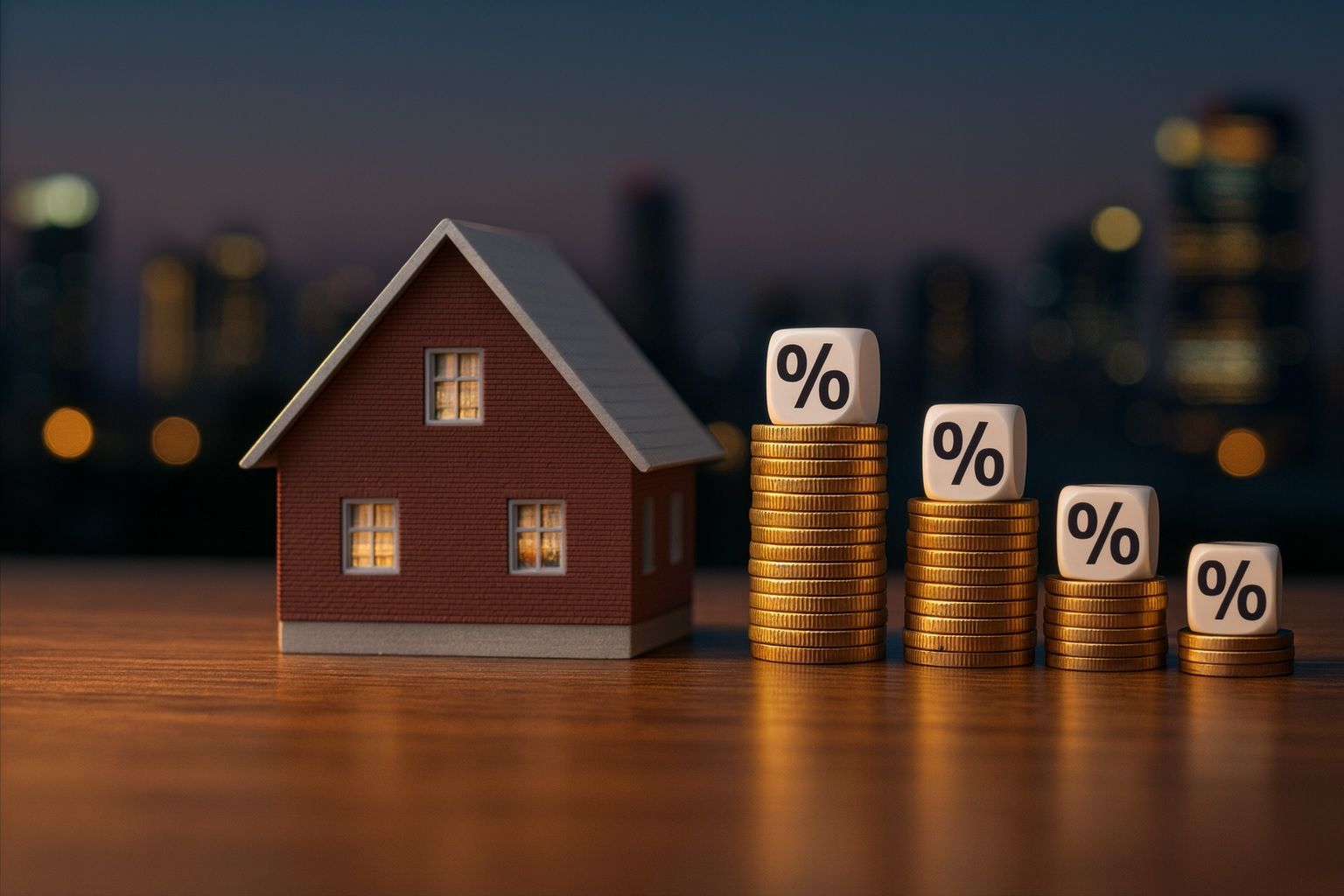- Hopes vs Reality: Many would-be homebuyers are holding off purchases in anticipation of lower mortgage rates, with surveys showing nearly two-thirds of Americans optimistic that rates will drop soon [1]. Redfin agents note a sub-6% 30-year mortgage could bring a “critical mass” of buyers back into the market [2]. Yet today’s average 30-year fixed rate remains around 6.2–6.3%, barely down from a year ago [3] and more than double the pandemic lows, tempering those hopes.
- Rates Stuck in Mid-6% Range: The 30-year mortgage dipped to ~6.27% this month – the lowest level of 2025 [4] – after spending weeks in the mid-6% range. But that modest decline has already stalled and even ticked back up as of October 23 [5]. Analysts warn that high federal debt and inflation are keeping long-term interest rates elevated, which in turn prevents mortgage costs from falling much further [6]. Former Treasury Secretary Larry Summers even cautions that America’s “unsustainable” debt load could drive a spike in borrowing costs ahead if not addressed [7].
- Expert Forecasts Dim Rate-Cut Hopes: Industry economists are pouring cold water on the notion of a quick drop in mortgage rates. At its annual conference last week, the Mortgage Bankers Association (MBA) predicted 30-year rates will stay above 6% for the foreseeable future [8]. “While many are betting [mortgage] rates will dip below 6% sometime next year, that is not showing up in the data yet,” says MBA chief economist Mike Fratantoni [9]. Likewise, Fannie Mae’s latest outlook foresees rates around 6.4% at end-2025, only sliding below 6% by late 2026 [10]. In short, don’t expect a return to 5% mortgages imminently, despite buyers’ optimism.
- Housing Market in a Holding Pattern: The prolonged 6%+ mortgage era continues to chill the housing market. Existing-home sales in 2024 fell to a 30-year low, and 2025 sales remain even weaker [11]. Pending home sales are still down ~1–2% year-over-year as of last month [12], and the typical home is sitting on the market 48 days – the slowest September since 2019 [13]. “Most home buyers are still on the sidelines,” observes NAHB chairman Buddy Hughes, even as builders cut prices to lure demand [14] [15]. Would-be buyers simply “aren’t budging” until financing costs come down further [16], creating a standoff between buyers and sellers.
- Fed Easing Meets High Treasury Yields: The Federal Reserve’s pivot to cutting interest rates (after its first rate cut of 2025 in September) has so far failed to pull down mortgage rates [17]. Markets fully expect additional Fed rate cuts in late October and December [18]. But mortgage lenders price loans off the 10-year Treasury yield, which remains stuck ~4% or higher [19]. Heavy government borrowing to finance deficits is flooding the bond market, keeping long-term yields elevated [20]. As one economist notes, “only Congress can rein in the spending that keeps long-term yields — and mortgage rates — stubbornly high” [21]. Until that pressure eases, Fed cuts alone aren’t enough to break mortgages out of their holding pattern.
- Outlook and Advice: Barring a major economic surprise, most analysts see mortgage rates hovering in the mid-6% range into early 2026 [22] [23]. Pantheon Macroeconomics expects no meaningful housing rebound until mid-2026, given only slight rate relief and persistent job market worries [24]. That means buyers banking on a rapid rate plunge could be waiting a long time. “Looking ahead… the likely bet is they are not going to fall much further,” says Bright MLS economist Lisa Sturtevant, warning that those holding off for dramatically lower rates “could find themselves facing higher home prices but without an improvement in mortgage rates” [25]. Her advice: plan pragmatically. Prospective buyers should get pre-approved and be ready to act if a suitable home and rate come along, rather than trying to time a perfect low. And “don’t assume rates will keep falling” — any dip could be temporary if economic conditions shift [26]. In short, cautious optimism is warranted: relief is likely to come gradually rather than suddenly, so patience and preparation will be key for 2025’s homebuyers.
Buyers Pin Hopes on a Rate Drop, But Patience Wears Thin
Despite sky-high home prices and a two-year slump in sales, homebuyer optimism is oddly resilient – largely because so many buyers are betting that mortgage rates have to come down soon. Consumer surveys show a majority of Americans expect borrowing costs to ease in the near future [27]. After all, 30-year mortgage rates have finally edged down from their 7%+ peak earlier in the year to around 6.2%–6.3% recently [28], which feels like progress. In fact, this month rates briefly hit 6.27%, the lowest level in about a year [29]. That dip, combined with a slight rise in housing inventory and cooling home prices, has given some house hunters hope that 2025 might bring relief.
Real estate agents report a palpable “wait-and-see” mentality among buyers. Many first-time buyers who got squeezed out of the market in 2022–2023 are still sitting on the sidelines, mortgage pre-approvals in hand, waiting for rates to fall to more affordable levels. Redfin data underscores this standoff: pending home sales have declined as shoppers hold off, and the typical home now takes significantly longer to sell because buyers are reluctant to commit at today’s rates [30] [31]. “Most home buyers are still on the sidelines,” says homebuilder group NAHB’s chairman Buddy Hughes, noting that only the luxury segment is showing firm demand while average buyers remain hesitant [32].
Crucially, there’s a sense that “magic number” mortgage rate that would unlock demand. A survey last year found 42% of respondents cited a 5% mortgage as their “sweet spot” that would compel them to buy, with nearly as many saying even 6% could motivate them [33] [34]. Real estate brokers echo this: if rates dip below 6%, it could be a game-changer. “If mortgage rates drop below 6%, we could see a critical mass of homebuyers return to the market,” Redfin’s economics team predicted [35]. In other words, there’s pent-up demand waiting for just a modest improvement in financing costs. For now, though, that threshold remains tantalizingly out of reach – and many buyers, encouraged by headlines of Fed rate cuts, are banking on hitting that mark in 2024.
The risk is that this optimism may be misplaced, or at least premature. Mortgage rates are not guaranteed to keep falling from here – and even if they do, it could happen very slowly. Those dreaming of a rapid drop into the 5% range may need a reality check, as we’ll see from what the data and experts are saying. But in the meantime, the collective hope for cheaper loans has effectively frozen a large chunk of the housing market: buyers and sellers are at a standoff, inventory is piling up, and everyone is waiting for the same thing – a break in the interest rate clouds.
Mortgage Rates Stubbornly High Despite Fed’s Rate Cuts
Ironically, the very reason so many buyers grew optimistic – the Federal Reserve shifting to rate cuts – hasn’t delivered much direct relief on mortgages. In mid-September, the Fed implemented its first interest rate cut of 2025, a quarter-point trim off short-term rates [36]. It signaled more easing to come, with Fed officials (like Governor Michelle Bowman) indicating two more 0.25% cuts by year-end [37]. Financial markets have already priced in those moves, confidently betting on additional Fed cuts at the late-October and December meetings [38]. Normally, such central bank easing would send borrowing costs tumbling across the board – but this time, mortgage rates barely blinked.
Why? The answer lies in the other side of interest rates: long-term bond yields. Most U.S. home loans are pegged to the 10-year Treasury yield, not the Fed’s overnight rate. And while the Fed was cutting, the 10-year yield was rising – hitting its highest levels in 17 years earlier in October [39]. Even now, the 10-year Treasury sits around 4.0%–4.3%, up from ~3.8% a year ago [40]. That upward pressure comes largely from the U.S. government’s enormous borrowing needs. As Washington issues mountains of new Treasury bonds to finance big deficits, it’s flooding the market and driving down bond prices – which pushes yields up. “Surging federal debt (now ~$36 trillion) has pushed the 10-year Treasury yield up,” explains economist Paul Mueller of the American Institute for Economic Research [41]. In his view, “only Congress can rein in the spending” that’s keeping long-term interest rates – and thus mortgage rates – stubbornly high [42].
This dynamic has created a disconnect: the Fed is easing policy, but mortgages haven’t gotten much cheaper because the bond market is worried about inflation and government debt. Mortgage lenders have little choice but to follow those 10-year yields. As a result, the average 30-year fixed mortgage rate is still ~6.2% [43] – roughly the same as one year ago, despite over a full percentage point of Fed rate cuts in that time [44]. In fact, Freddie Mac’s weekly survey recently put the 30-year at 6.27%, which is near the lowest level in the past 12 months but hardly a dramatic decline [45]. It’s a far cry from the 3% mortgages homeowners enjoyed in 2021.
The bottom line: long-term borrowing costs remain elevated, stuck in a narrow range. “Mortgage rates have fallen only slightly over the last three months,” notes Samuel Tombs, chief U.S. economist at Pantheon Macroeconomics, adding that anxious views of the job market mean housing “demand will remain weak ahead” [46]. In his assessment, a real recovery in homebuying “is unlikely before mid-2026” [47] given where rates and the economy are. That’s a sobering timeline for anyone expecting quick relief.
To be sure, there has been some easing from the peak: the 30-year rate topping out above 7% earlier in 2025 was painful, and drifting back to ~6.3% does save borrowers some money. Mortgage refinance applications even ticked up modestly during the recent dip [48], as a slice of homeowners were able to snag slightly lower payments. But we’re talking baby steps. As mortgage analysts at Fortune put it this week, rates remain “in a narrow range” and any improvements have been incremental – prompting the question of whether this is “a trend” or just a blip [49]. So far, it looks more like a plateau. Until something gives in the economy or policy, 6%-plus mortgages might be the new normal for a while.
Experts Pour Cold Water on Hopes of Sub-6% Rates Soon
Given buyers’ high hopes, what do seasoned economists and industry experts foresee for mortgage rates? In a word, caution. Forecasters largely agree that a substantial drop in mortgage rates is not imminent – and certainly not guaranteed in the next few months.
Take the Mortgage Bankers Association (MBA), which represents home loan providers. At the MBA’s annual convention (held Oct 15–18 in Las Vegas), the message was sobering: don’t count on rates falling below 6% in the near future [50]. MBA’s chief economist Mike Fratantoni said that with the 10-year Treasury likely to stay in the 4.0–4.5% range “going forward,” long-term mortgage rates are actually more likely to “go higher rather than lower” in coming months [51]. While “many are betting” on sub-6% loans in 2024, Fratantoni noted, that optimistic scenario “is not showing up in the data yet” [52]. In other words, the hard evidence – inflation readings, bond market trends, global yields – doesn’t yet support the idea of a sharp decline in U.S. mortgage rates.
Other major forecasts echo this restrained outlook. Fannie Mae’s latest economic forecast (September 2025) projects the average 30-year fixed rate at 6.4% by end-2025, then 5.9% by end-2026 [53]. That implies a very gradual glide lower over the next year, finally dipping just under 6% around two years from now. The National Association of Realtors (NAR) likewise expects rates to hover in the mid-6% range through most of 2025, perhaps reaching the low 6’s or high 5’s by late 2026 [54]. It’s a far cry from the sub-5% mortgages that powered the 2020 housing boom; no credible forecaster sees those returning anytime soon. The consensus: 2025 will still be a high-rate environment by historical standards, even if the worst is behind us.
Why so glum? For one, inflation remains a concern. The MBA’s economists warned that price pressures could pick back up in coming months, which would keep upward pressure on interest rates [55]. “After all that work we went through to get inflation under control, it sure looks like it’s going the other way,” Fratantoni said, pointing to risks like rising oil prices and tariffs [56]. If inflation stops decelerating, the Fed might slow or pause its rate cuts, and bond investors would demand higher yields – both of which could stall or reverse any mortgage rate declines.
Secondly, even if inflation behaves, there are structural issues. Massive government deficits, as discussed, are one. Global factors play a role too: if overseas investors see U.S. debt as riskier or want higher returns, long-term rates can rise independent of the Fed. Uncertainty around things like U.S. fiscal policy, geopolitical tensions, or another government shutdown (the October federal funding standoff is fresh in mind) can all keep mortgage rates from falling much [57].
On a more optimistic note, the Fed is likely to continue cutting rates into 2025 – MBA expects two more cuts this year and even one next year [58] – and that eventually should trickle through. By 2026, if the economy slows and inflation is clearly tamed, we could see the alignment of lower short-term rates and easing long-term pressures that finally brings the 30-year mortgage sustainably back under 6%. Indeed, Fannie Mae’s research team believes that by late 2026, the pieces will fall into place for a high-5% mortgage rate – not a windfall, but a meaningful improvement [59]. Housing analysts often cite 6% as an important psychological threshold; rates above that tend to really crimp affordability. So crossing below 6, even to say 5.8%, could spur activity. The catch is, this may take another 18–24 months, not 18–24 weeks.
For potential homebuyers, the implication is clear: temper your expectations. “Looking ahead… they are not going to fall much further,” advises Bright MLS’s Lisa Sturtevant, referencing mortgage rates [60]. Those who keep waiting indefinitely for a huge drop might end up disappointed – or priced out in other ways. Sturtevant notes that if you delay a purchase for years waiting for a 4% mortgage that never materializes, you could easily find home prices have climbed higher in the meantime, wiping out any savings from a slightly lower interest rate [61]. That sentiment is shared by many experts: it’s unwise to try to “time the market” with mortgage rates. Yes, rates are important – but so is finding the right house you can afford. With rates likely staying in a stable band, buyers may want to focus on what they can control (like improving their credit, saving for a bigger down payment, and shopping around for the best lender) rather than hoping for a rate miracle.
Housing Market Faces Gridlock as Affordability Bites
The direct consequence of these high-but-stable mortgage rates is a continuing gridlock in the housing market. Affordability remains extremely challenging. At ~6.3%, mortgage rates are more than double the record lows of 2021, yet home prices in many areas have not fallen substantially to compensate [62]. This double-whammy – higher financing costs on still-high prices – means the typical monthly payment for a median home is up drastically from a few years ago. By one estimate, the principal-and-interest payment on a median-priced home is about $2,067 as of September, down a bit from its peak earlier in 2024 but still far above pre-pandemic levels [63]. Meanwhile, other costs of homeownership (taxes, insurance) have been rising as well, further crimping buyers’ budgets [64]. It’s no surprise that homebuyer sentiment – whether it’s a good time to buy – is near record lows in surveys, despite the noted optimism about future rates. People are hopeful for tomorrow, but discouraged about today’s conditions.
Sales data bear this out. Existing home sales (resales of condos and single-family homes) in 2024 fell to their lowest annual total since the early 1990s [65], and 2025 is trending even weaker. Would-be sellers are hesitating to list their homes – especially those who refinanced into sub-3% mortgages and don’t want to give that up – so inventory of homes for sale has been tight. Yet buyers, facing those steep monthly costs, aren’t exactly rushing in either. The result: very low transaction volumes. Redfin’s tracking shows home sales year-to-date are below last year’s anemic pace [66], and homes that do hit the market often sit for longer. The median days on market has stretched to nearly 7 weeks, when in the frenzied 2021 market it was barely over 1 week [67]. Price growth has cooled (nationally, prices are roughly flat to up only a couple percent year-over-year), but we haven’t seen deep price declines broadly – which some buyers are waiting for as well. In effect, the housing market is in stalemate.
New construction is one relative bright spot: homebuilders have managed to sell new homes by offering incentives and rate buydowns to buyers. In fact, homebuilder sentiment in October jumped to its highest in six months, reflecting hopes that slightly lower mortgage rates might boost new home demand [68] [69]. However, even the NAHB (National Association of Home Builders) admits conditions remain tough – that sentiment index is still well below neutral (at 37, versus 50 being “good” conditions) [70]. Builders reported having to cut prices on 38% of new homes in October to entice buyers, with an average discount of 6% [71]. There’s also an overhang of unsold new homes in some markets [72], since higher rates priced out many buyers who would normally move up to a brand-new house. So while builders are a bit more upbeat (they see a lot of pent-up demand once rates improve), they are still operating in a highly constrained environment.
The longer this goes on, the more pressure builds in the system. Demographically, millions of Millennials would love to become homeowners, and each year new households form that eventually need housing. This demand doesn’t disappear – it’s delayed. Economists talk about a potential “spring-loaded” effect: if and when rates do fall notably, the housing market could see a sudden surge of activity as all that pent-up demand is released. But timing is everything. If rates stay at 6-7% well into 2025 or 2026, some households might simply give up or adjust their expectations (e.g. opting for smaller homes, different locations, or renting longer). Others, as surveys indicate, are waiting out the 2024 election or other developments [73], hoping a clearer economic picture will emerge.
Meanwhile, the rental market has benefited somewhat – with fewer buyers, demand for rentals has stayed strong, and rent inflation has been more persistent than many forecast. Yet if high interest rates eventually tame overall inflation and potentially lead to a recession, that could soften rents and incomes, making it even harder for renters to save for a down payment. It’s a complicated web, but at its center is the fact that borrowing money is expensive again, and that touches every corner of the housing sector.
Stocks and Markets Reflect Cross-Currents
Interestingly, while real estate has been reeling from high rates, the stock market has been partying like it’s 2021. Investors in equities have taken a very different view of the Fed’s rate cuts and the economic outlook. The prospect of easier monetary policy has fueled a major rally in tech stocks and other rate-sensitive parts of the market. In fact, the Nasdaq and S&P 500 index both hit all-time highs in early October [74]. The S&P 500 is up roughly 15% year-to-date (and the tech-heavy Nasdaq about 18% YTD) as of mid-October [75]. Wall Street, it seems, is focusing on the positives of lower short-term rates – like stronger corporate earnings and cheaper financing for companies – and largely shrugging off the still-high long-term yields (or assuming they too will eventually fall).
This divergence between Wall Street exuberance and the Main Street housing struggle is notable. Homebuilder stocks and real estate investment trusts (REITs) haven’t rallied nearly as much, precisely because their fortunes are tied to those stubborn mortgage rates. But the broader market’s strength does have some spillover: it reflects an economy that, so far, is avoiding recession. A reasonably healthy job market and rising incomes (for those who have jobs) at least provide some support for housing – people need to be employed to qualify for mortgages, after all. However, if the stock market is wrong and we hit an economic rough patch next year, that could chill housing even more (as job loss fears mount), even if rates tick down. The opposite could also be true: if the economy stays resilient and inflation fades, long-term yields might finally ease and give us the “goldilocks” scenario of solid growth and lower mortgage rates – a boon for real estate.
For now, though, the markets are sending mixed signals. Bank stocks popped higher recently on strong earnings – for instance, Morgan Stanley and Bank of America shares jumped ~4-5% in mid-October [76] – suggesting lenders are coping fine and credit isn’t seizing up. Yet those same banks report far fewer mortgage originations this year, as consumers simply aren’t refinancing or moving as much. Housing-related stocks like Zillow, Redfin, and Rocket Mortgage remain well below their pandemic-era highs, reflecting the tough environment for real estate transactions. In contrast, big tech companies (which thrive when interest rates fall) are soaring on AI-fueled optimism [77]. It’s an odd economic puzzle: the cost of money is high for households but low for Silicon Valley, in a sense, thanks to differing sensitivity to Fed policy.
One takeaway is that if you’re a house hunter feeling frustrated, you’re not alone – and you might even take some solace that the overall economy’s strength could eventually help housing recover. Low unemployment and wage growth, if maintained, mean there are a lot of potential buyers out there who want homes when conditions improve. The stock market’s confidence in the future can be seen as a vote that better days (and maybe better rates) are coming. Just don’t expect it overnight.
Preparing for the Long Haul: What Homebuyers Should Do Now
With no quick fixes on the horizon, what should aspiring homebuyers be doing? Experts have a few pieces of advice:
1. Get Financially Prepared: Use this lull to shore up your finances. Strengthen your credit score (which can help you secure a lower mortgage rate than average). Save as much as possible for a down payment – not only will that reduce your loan amount, but larger down payments are impressing sellers in this slower market [78] [79] (and affluent buyers are out there putting 30-50% down to offset high rates [80]). Also, if you have existing debts, try to pay them down; lower debt-to-income ratios will improve your mortgage affordability.
2. Shop Around and Consider Alternatives: Even if the prevailing 30-year rate is ~6.3%, there’s a lot of variation. Different lenders may offer different rates or incentives, so shop around for mortgage quotes. And consider if an adjustable-rate mortgage (ARM) might make sense for your situation. MBA’s data shows more refinancers are opting for ARMs to get a temporarily lower rate [81]. An ARM carries risk (the rate can rise later), but if you expect to refinance in a few years once fixed rates hopefully drop, it could bridge the gap. Just be sure you could handle the worst-case adjustment or have a backup plan.
3. Stay engaged with the market: Even if you’re waiting on rates, keep looking at listings and maybe even attending open houses. The slower market now means buyers face less competition. If you find a home that checks all your boxes and the seller is motivated (maybe willing to negotiate price or pay points for a rate buydown), it could actually be a good time to strike a deal. As one CBS News analysis put it: “Get pre-approved right now” so you’re ready to move quickly, but “don’t assume rates will keep falling” – they “can easily tick back up” if conditions change [82]. In other words, use any dip to your advantage rather than holding out for a dip that may not deepen much.
4. Think long-term: If you buy now or soon, you might pay a bit of a premium on your interest rate. But remember, you can refinance later if rates truly plunge. Marry the house, date the rate, as the saying goes. What you can’t get back is time if home prices and rents keep rising. So weigh the cost of waiting (extra years of rent or rising home prices) versus the savings of a possibly lower rate in the future. Often the math shows it’s not worth chasing a 1% rate difference if it means postponing homeownership for several years – especially if you find a home you love. Each person’s situation will differ, of course, but the key is to stay informed and realistic.
Bottom Line: The great mortgage rate standoff of 2025 continues. Buyers are optimistic that relief is around the corner, and indeed rates have eased off their highs, but experts urge caution in assuming a rapid plunge. All signs point to gradual improvement at best – perhaps a slide into the low-6% or high-5% range over the next year or two [83] [84], barring economic surprises. In the meantime, the housing market will likely remain sluggish, defined by hesitant buyers, reluctant sellers, and creative workarounds to make deals happen (like price cuts and mortgage buydowns).
For prospective buyers, the mantra should be “hope for the best, prepare for the worst.” Hope that the analysts are too pessimistic and that inflation cools faster, the bond market calms down, and mortgage rates finally drift downward. But prepare for the scenario that rates could just as easily edge back up due to some shock, or simply stay stuck around 6% for longer than you’d like. By getting your finances in order and staying alert, you’ll be in position to take advantage of opportunities – whether that’s a sudden rate dip or a softening home price – rather than missing out.
As the MBA’s forecast and others remind us, this may simply be the new reality we have to adapt to: “it looks like this is about the market we will be living in,” Fratantoni said of the current climate [85]. But markets are always changing, and the only certainty is that today’s tough conditions won’t last forever. The second half of the decade could bring fresher winds for housing – just don’t hold your breath for a miracle in the final months of 2025. Patience, prudence, and perseverance will serve homebuyers far better than wishful thinking in the months ahead.
Sources: CNBC, Fortune, Yahoo Finance, TechStock² (ts2.tech) [86] [87], Reuters [88], Mortgage Bankers Association [89], Fannie Mae [90], National Association of Realtors, Freddie Mac, Pantheon Macroeconomics, Bright MLS, Redfin, NAHB, CBS News, and others.
References
1. www.prnewswire.com, 2. www.redfin.com, 3. ts2.tech, 4. ts2.tech, 5. economictimes.indiatimes.com, 6. ts2.tech, 7. economictimes.indiatimes.com, 8. nationalmortgageprofessional.com, 9. nationalmortgageprofessional.com, 10. www.fanniemae.com, 11. ts2.tech, 12. ts2.tech, 13. ts2.tech, 14. www.reuters.com, 15. www.reuters.com, 16. ts2.tech, 17. ts2.tech, 18. ts2.tech, 19. ts2.tech, 20. ts2.tech, 21. ts2.tech, 22. nationalmortgageprofessional.com, 23. nationalmortgageprofessional.com, 24. www.reuters.com, 25. ts2.tech, 26. ts2.tech, 27. www.prnewswire.com, 28. ts2.tech, 29. ts2.tech, 30. ts2.tech, 31. ts2.tech, 32. www.reuters.com, 33. www.prnewswire.com, 34. www.prnewswire.com, 35. www.redfin.com, 36. ts2.tech, 37. ts2.tech, 38. ts2.tech, 39. ts2.tech, 40. ts2.tech, 41. ts2.tech, 42. ts2.tech, 43. ts2.tech, 44. ts2.tech, 45. ts2.tech, 46. www.reuters.com, 47. www.reuters.com, 48. ts2.tech, 49. www.reddit.com, 50. nationalmortgageprofessional.com, 51. nationalmortgageprofessional.com, 52. nationalmortgageprofessional.com, 53. www.fanniemae.com, 54. www.forbes.com, 55. nationalmortgageprofessional.com, 56. nationalmortgageprofessional.com, 57. ts2.tech, 58. nationalmortgageprofessional.com, 59. www.fanniemae.com, 60. ts2.tech, 61. ts2.tech, 62. ts2.tech, 63. nationalmortgageprofessional.com, 64. nationalmortgageprofessional.com, 65. ts2.tech, 66. ts2.tech, 67. ts2.tech, 68. www.reuters.com, 69. www.reuters.com, 70. www.reuters.com, 71. www.reuters.com, 72. www.reuters.com, 73. www.prnewswire.com, 74. ts2.tech, 75. ts2.tech, 76. ts2.tech, 77. ts2.tech, 78. nationalmortgageprofessional.com, 79. nationalmortgageprofessional.com, 80. nationalmortgageprofessional.com, 81. nationalmortgageprofessional.com, 82. ts2.tech, 83. nationalmortgageprofessional.com, 84. www.fanniemae.com, 85. nationalmortgageprofessional.com, 86. ts2.tech, 87. ts2.tech, 88. www.reuters.com, 89. nationalmortgageprofessional.com, 90. www.fanniemae.com










